Dr. Adema Ribic, 31 Ocak 2019’da, UMRAM/Aysel Sabuncu Beyin Araştırma Merkezi’nde seminer verdi.
Seminerin başlığı: “Synaptic Brakes on Neuroplasticity: Mechanism of Critical Period Closure in Visual Cortex”.
Dr. Adema Ribic: Şu anda “Tufts University School of Medicine Sinirbilimi Bölümü’nde araştırma görevlisi olan Dr. Ribic’in “Journal of Neuroscience, Journal of Comparative Neurology, and Behavioral Brain Research” gibi dergilerde yayınları bulunmaktadır. Doktorasını Almanya’daki Göttingen Üniversitesi Moleküler Biyoloji ve Sinirbilimi’nde tamamlayan Ribic, post-doktorasını Yale Üniversitesi’nde yaptı.
Abstract: Connections between nerve cells in the brain, termed synapses, are formed using precise genetic programming and are remodeled with experience throughout lifetime. Synaptic remodeling is a highly regulated process, prominent in the developing, young brain when plasticity is high. Brain plasticity in mammals tapers off in adulthood, paralleling the maturation of inhibitory neurotransmission and a steady increase in the expression of nerve growth inhibitors. The goal of my research is to identify mechanisms that act at the synapse to direct synaptic remodeling and plasticity. My recent research demonstrated a key role of Synaptic Cell Adhesion Molecule 1 (SynCAM 1/Cadm1) in maturation and plasticity of visual cortex. SynCAM 1 is a synaptic organizer that selectively controls development of subcortical, thalamic inputs onto Parvalbumin (PV+) inhibitory interneurons in the visual cortex. Loss of SynCAM 1 in PV+ interneurons retards the maturation of cortical inhibition and mice deficient in SynCAM 1 show increased visual plasticity at all ages, indicating that synaptic adhesion directs brain maturation. Even a brief loss of SynCAM 1 in PV+ interneurons upregulates plasticity in the adult brain, suggesting that plasticity is actively restricted through SynCAM 1 in adults. These results identify a synaptic locus for closure of developmental windows of plasticity, as well as a new synaptic factor that restricts adult plasticity.
